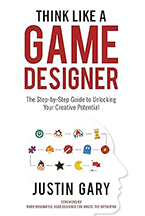December 28, 2024
Think Like a Game Designer
The Step-by-Step Guide to Unlocking Your Creative Potential
Justin Gary
Aviva Publishing (2018)
ISBN: 978-1-947937-39-0 (hardcover), 978-1-947937-40-6 (ebook)
New How-To Book Reveals Secrets of Master Game Designer
 In Think Like a Game Designer, longtime game designer Justin Gary walks readers through everything they need to know to come up with great game concepts, create their games, test them, and successfully bring them to market. Even people who just love to play games will enjoy this book because of the inside look it provides into the creative and analytical mind of a great game designer.
In Think Like a Game Designer, longtime game designer Justin Gary walks readers through everything they need to know to come up with great game concepts, create their games, test them, and successfully bring them to market. Even people who just love to play games will enjoy this book because of the inside look it provides into the creative and analytical mind of a great game designer.
For those who don’t recognize Gary’s name, he began his career by gaming. At age seventeen, he won the Magic: The Gathering US National Championships. He continued to play Magic professionally for many years, winning several more championships. Gary began designing games by working on the Vs. System trading card game and went on to lead-design the DC Comics: Infinite Crisis set. Afterwards, he created the World of Warcraft Miniatures game before starting his own company, Gary Games, in 2010, which released the hit deck-building game Ascension that year. His credentials just go on and on from there.
In Think Like a Game Designer, Gary reveals the secrets to his success, and any honest artist will tell you that those secrets boil down to having common sense and a willingness to work hard. Most people never succeed because they are afraid their ideas are bad and because they don’t make the effort to bring them to fruition. Gary will be the first to tell you that it’s okay to have bad ideas. You have to have lots of them to get to the good ones, and the first game you design will not be good, but you will keep learning from your mistakes. Ultimately, game designers must learn to create enjoyable experiences for their audiences. That means continually tweaking ideas until they are right.
Think Like a Game Designer is divided into five sections: Understanding Design, Learning the Core Design Loop, Refining Your Designs, Building Great Games, and Making Money. Each section is then broken into several chapters. The book truly does take the reader “step-by-step,” and while I don’t have room to elaborate upon all of those steps, I’ll mention a few of the insightful highlights for me.
First and foremost, I was blown away by one simple key to gaming that Gary shares: “To be a great game designer, you must be able to predict your players’ emotional responses to the rules you design. Predictions require a degree of empathy and the ability to understand why people play games.” To me, this really explained the magic of gaming. Gamers want to be entertained; they want to experience the emotional ups and downs of the game. Gary talks about how you want to avoid making your players become so frustrated that they will want to quit playing; instead, you must entice them to continue to play in hopes of winning. Gary goes on to teach how to capitalize on the Big Moments in games that keep the game exciting for everyone, such as when a player in last place surges forward to win.
Gary is continually honest with his readers. He has no problem telling them “your first game is going to suck” and goes on to explain, “I’m just sharing a basic fact that is as true for you as it is for me and every great designer I know. Only the people who make games that suck then move on to create something awesome.” At the same time, he removes any mysticism from the creative process. In Chapter 4, he states, “This chapter will bring inspiration down to earth. Everyone can be inspired and everyone can be creative. Despite all the hype to the contrary, inspiration is both the easiest and least important part of the design process.”
Gary also encourages people to get feedback as early as possible by sharing their ideas to make sure they are good:
“Ideas are important, but not as important as everyone thinks. Think of your game idea as the foundation for a house. If it isn’t solid, the house is in trouble. On the other hand, without all the planning, labor, and resources required to build an actual house, all you have is an empty lot. Sharing your idea early helps you make sure you have a good foundation before investing in building your house.
“I’ve encountered multiple designers who were terrified that someone would steal their brilliant game concept. So terrified, in fact, that they never showed it to anyone. Those game ideas may have been brilliant, but no one will ever know because they never saw the light of day.”
Finally, I appreciate that Gary gives readers a reality check about the gaming industry. He tells us, “The question I get asked most often by fans and players at conventions is: How do I get a job in the gaming industry? If you are reading this book, the odds are good that you have a similar goal. The answer I always give is counterintuitive: The easiest way to get paid in the game industry is not to get paid in the game industry.
“Despite sounding like a Zen riddle, the above answer is a great guideline for anyone new to the industry. What it means is that you should start doing work in games so you can prove yourself as someone worth hiring in the future. The gaming industry is competitive, and game companies are always on the lookout for pleasant, smart, hardworking people to help them be successful. Be one of those people and you will have no trouble finding a job in the long run.”
There is so much more I could say about the design process that Gary walks readers through, but it would be better just to let you read the book and apply the process and concepts for yourself. What I will say is that Gary offers a refreshing and invaluable look into the process of game design and anyone interested in learning that process would do well to read and study this book multiple times.
For more information about Justin Gary and Think Like a Game Designer, visit www.JustinGary.com.
— Tyler R. Tichelaar, PhD and award-winning author of The Gothic Wanderer and Haunted Marquette

